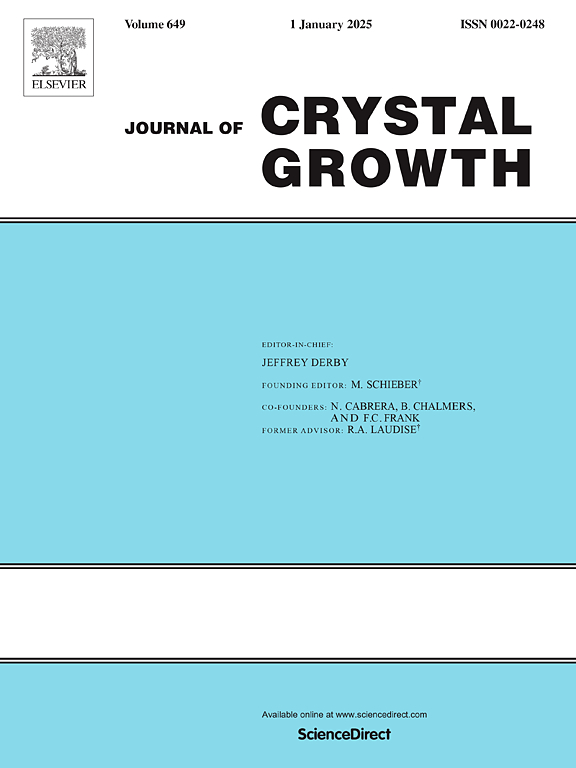简单蛋清白蛋白法制备MgFe2O4纳米颗粒的低温和高温磁性能
IF 2
4区 材料科学
Q3 CRYSTALLOGRAPHY
引用次数: 0
摘要
由氧化铁和一种金属元素组成的铁氧体型磁性纳米颗粒由于其宝贵的物理、机械、光学、催化和磁性能而引起了广泛的应用。然而,通过各种常规方法生产的铁氧体纳米颗粒的磁性能往往达不到许多应用所需的规格。开发一种简单、经济、无毒的制备方法至关重要。一种相对简便、经济、环保的方法一直是研究的重点。本研究旨在利用生态友好的新鲜提取蛋白法合成MgFe2O4 (MFO)尖晶石铁氧体,并在2 ~ 900 K范围内研究其详细的结构和高温磁特性。讨论了制备的MFO纳米颗粒的相纯度、粒径、形貌、表面特征、元素确认、光学性质、元素状态和磁性。制备的MFO纳米颗粒呈立方晶体结构,符合Fd-3 m的空间群,平均粒径为20 nm。紫外-可见吸收分析表明,MFO纳米颗粒的光学带隙为3.32 eV。XPS光谱证实了MFO的混合尖晶石类型。磁滞回线的温度变化表明其具有超顺磁性,但存在有限矫顽力(Hc)。MFO纳米颗粒的Hc、Mr和Ms分别为50Oe、2emu /g和26emu /g。从MFO纳米颗粒的Mr/Ms比值观察到,在100 K以上,MFO纳米颗粒在自然界中向多畴转变。磁化温度变化研究表明,转变温度在588 K左右。详细的磁性行为研究和解释的模型支持理论研究。本文章由计算机程序翻译,如有差异,请以英文原文为准。
Low and high temperature magnetic properties of MgFe2O4 nanoparticles synthesized by a simple egg white albumin route
Ferrite type magnetic nanoparticles composed of iron oxide and a metallic element have been attracting considerable interest in manifold applications due to their valuable physical, mechanical, optical, catalytic, and magnetic properties. However, the magnetic properties of ferrite nanoparticles produced via various conventional methods often fall short of the desired specifications for many applications. It is essential to develop an easy, cost-effective, and non-toxic method of preparation. A relatively facile, cost-effective and environment friendly method has been a key focus of research. This study aims to synthesize the MgFe2O4 (MFO) spinel ferrite using eco-friendly freshly extracted egg-white albumin method and study the detailed structural as well as the high temperature magnetic characteristics over a wide range of temperature from 2 K to 900 K. The phase purity, particle size, morphology, surface features, elemental confirmation, optical properties, elemental states as well as the magnetic characteristics of the prepared MFO nanoparticles were discussed. The prepared MFO nanoparticles were exhibited a cubic crystal structure in confirmation to a space group of Fd-3 m with an average particle size of 20 nm. UV–Visible absorption analysis of MFO nanoparticles showed an optical band gap of 3.32 eV. Mixed spinel type of MFO is confirmed from XPS spectra. The temperature variation of hysteresis loop suggested a super paramagnetic like behavior, however, a finite coercivity (Hc) was observed. The Hc, Mr, and Ms of the MFO nanoparticles were observed to be 50Oe, 2 emu/g and 26 emu/g, respectively. It was observed from the e Mr/Ms ratio of MFO nanoparticles that the particles are transforming into multi domain in nature above 100 K. The temperature variation of magnetization studies revealed a transition temperature is at around 588 K. Detailed magnetic behavior is investigated and explained by the models supported by theoretical studies.
求助全文
通过发布文献求助,成功后即可免费获取论文全文。
去求助
来源期刊

Journal of Crystal Growth
化学-晶体学
CiteScore
3.60
自引率
11.10%
发文量
373
审稿时长
65 days
期刊介绍:
The journal offers a common reference and publication source for workers engaged in research on the experimental and theoretical aspects of crystal growth and its applications, e.g. in devices. Experimental and theoretical contributions are published in the following fields: theory of nucleation and growth, molecular kinetics and transport phenomena, crystallization in viscous media such as polymers and glasses; crystal growth of metals, minerals, semiconductors, superconductors, magnetics, inorganic, organic and biological substances in bulk or as thin films; molecular beam epitaxy, chemical vapor deposition, growth of III-V and II-VI and other semiconductors; characterization of single crystals by physical and chemical methods; apparatus, instrumentation and techniques for crystal growth, and purification methods; multilayer heterostructures and their characterisation with an emphasis on crystal growth and epitaxial aspects of electronic materials. A special feature of the journal is the periodic inclusion of proceedings of symposia and conferences on relevant aspects of crystal growth.
 求助内容:
求助内容: 应助结果提醒方式:
应助结果提醒方式:


